The basement is the foot of the structure, located above the foundation. The lower part of the building can protrude, be flush or sink in relation to the vertical plane of the outer wall. The top of the strip foundation is sometimes the foot, and in the case of columnar supports, the pedestal is formed by a wall in the gaps between them. The decoration of the basement of a private house is carried out to protect against the negative effects of bad weather and to decorate the facade.
- The main task of facing the foundation of the house
- The construction of the basement of the house
- Flush with the wall
- Protrudes beyond wall level
- Falls over the level of the wall
- Advantages and disadvantages of finishing the foundation
- The choice of finishing material
- Plinth finish
- With bricks
- With natural or artificial stone
- With the help of corrugated board
- With siding
The main task of facing the foundation of the house
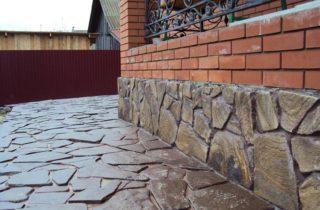
The lower part of the building is in contact with the ground, moistened from soil moisture, snow drifts. Finishing materials and protection technologies allow you to achieve a long service life of the base without major restoration.
The plinth plating is done to protect it from damage as a result of:
- mechanical shock;
- leaching;
- weathering of surface components;
- getting wet, freezing;
- solar insolation;
- the action of microorganisms.
The details of the facade are in harmony with each other, therefore, attention is paid to the finishing of the pedestal of the house at the finishing stage. The bottom of the facade is decorated in accordance with the technologies of using various materials. The geometric dimensions of the foundation may deviate from the norm during construction, and the finish of the basement brightens up the unevenness of the surface and gives the building a finished look.
The construction of the basement of the house
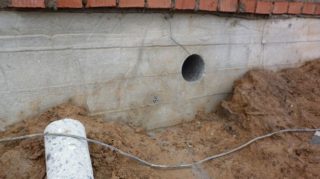
The plinth acts as a protection when organizing a basement and, as a retaining wall, takes on the force from backfilling the layers when installing the floor on the ground. The height is taken to be not less than 0.5 m, and in buildings with a basement, the protective wall rises by 1.5 - 2.0. Ventilation holes are arranged in the lower part of the house to ventilate the basement. The air is made about 15 x 20 cm in size, covered with a net and placed at least 15 cm from the ground every 3 rm. walls.
The width of the basement part in relation to the transverse dimension of the wall is taken differently:
- protrudes vertically outward by 5 - 10 cm;
- recessed inside by 5 - 10 cm;
- performed flush with the load-bearing railing.
The frame finishing of the foundation of a private house will push the vertical outward by 5 - 7 cm, while simple or decorative plaster will increase the size by 2 - 3 cm. The correct design option will prevent the destruction of the house and increase protection.
Flush with the wall
The top of the foundation is made the same width as the wall and the masonry does not go beyond the dimensions. A plinth in the alignment of the bearing vertical is not the best way to protect a building from moisture. A waterproofing layer is made on the surface of the foundation before the walls are erected and prevents it from getting wet. With the same offset, the edge of the protective membrane remains outside and exposed to the weather.
A galvanized apron is placed around the perimeter of the building so that its top goes horizontally into the joints of the basement and the wall. The lower part of the strip bends at an angle and rain, dew and other types of condensation flow down it.This addition to the façade limits moisture and prevents liquid from seeping into the joints, but does not decorate the building. The supporting part flush with the main wall should be made of a material that does not absorb moisture or has a minimum indicator. Such materials include silicate concrete, red clinker bricks, granite
Protrudes beyond wall level

A protruding bottom is obtained when the walls of the house are thin, for example, from foam concrete. The foundation is made massive due to the large weight of the floors or roofs. In this embodiment, the drainage system is thought out before the start of the wall laying in order to ensure the drainage of the liquid outside the joint. The horizontal surface of the protruding part is made at an angle outward in the process of tiling the foundation with tiles, natural or artificial stone, plastic panels.
The protruding foot of the house must be covered with materials that do not create a thick layer, since the base will protrude strongly forward. You can glue flat tile decor, finish the surface with metal. For the protruding foot, a plastic or galvanized ebb is made around the entire perimeter of the house.
Strong materials are selected with high resistance to mechanical stress, for example, impacts, chips. The protruding front part takes on the load from children's games, the constant passage of people.
Falls over the level of the wall

The recessed version of the foundation on the facade surface is the most convenient. The vertical is protected by an overhanging wall from oblique streams of rain, and moisture drains off quickly thanks to the free edge. In this case, it is important to calculate the bearing capacity of the foundation so that the narrow dimensions can withstand the weight of the building without destruction.
This option is obtained if a concrete base is made, columnar or pile screw supports. The walls are made of brick and have a large thickness (up to 510 mm), so the transverse dimensions of the foundation and the vertical fence do not match. The overlap of the wall prevents moisture from entering the horizontal joint and protects the basement from dampness.
Organized drainage is rarely done with a sinking option, so attention is paid to the blind area around the building. Water gets on it, so the width is taken at least 0.8 m, and the surface is made with a slope from the structure. The plinth can be sheathed with wood, corrugated board, other materials on the frame, or revetted with a budget option of tiled facing material.
Advantages and disadvantages of finishing the foundation
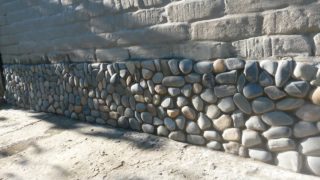
The main advantage is the protection of the building from negative weather and other factors. The cladding of the basement of the house prevents the basement from heating up in the summer heat and prevents freezing in winter. The foot is made of moisture-resistant materials, so the load-bearing wall does not get wet, moisture is not transferred to the outer insulation layer. The thermal conductivity of the building remains within the design norms.
The decorative finish complements the beautiful façade and is an integral part of the overall architectural design. Materials for decorating the bottom of the building are presented in a wide variety.
Disadvantages appear in the finish if substandard materials are used. Developers plaster the surface with a cement-sand mortar without plasticizers and mineral additives. Such a layer will last for several years, then it will have to be redone.
The choice of finishing material
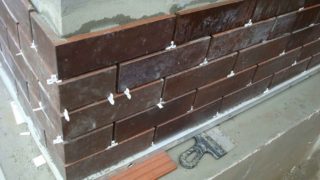
When choosing a material, pay attention to the properties:
- beautiful view and compliance with the architectural style;
- layer thickness;
- interaction with other materials, for example, insulation;
- technical characteristics, such as water absorption, thermal conductivity, density, weight, and others.
Frame materials create an additional base / plinth extension and are not always the best solution. In this case, it is better to cover the bottom of the wall with tiles, stone or decorative plaster. Sometimes corrugated board, plastic, siding can be installed without a frame, if the base material allows.
Plinth finish
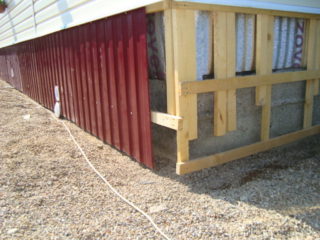
The lower part of the wall can be finished wet or dry. Wet types include plaster, painted putty, gluing tiles, flat bricks, natural or artificial stone to mortar. A certain skill is required to perform such work accurately and not to spoil the appearance of the facade.
The materials are fixed with an adhesive and the durability of the finish also depends on its quality. If a cement-sand mortar is used, special additives are introduced into it to increase the operational capacity. Wet technologies are used during the warm season.
Sheet, panel materials are fastened using a treated wooden lathing or a frame made of metal profiles. It is better to calculate the material after installing horizontal and vertical strips, because fasteners increase the surface of the finish.
With bricks
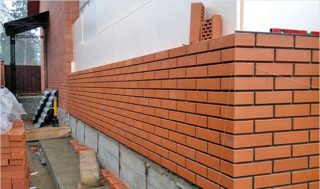
Decorative finishing bricks are used, the thickness of which, together with the mortar layer, is 75 - 85 mm. The line of manufacturers provides upper elements, external and internal corners for the design of masonry turns. There are hollow bricks for weight reduction. Types for external masonry are made by firing, while the primary components are sintered into a solid mass. Pressed products without firing are used.
The surface is prepared for cladding, irregularities are cleaned off, the basement area is primed. The waterproofing layer is arranged with roofing material, it is glued to the mastic. A mesh is placed for better adhesion of the mortar to the base and the tiles are laid, starting from the bottom row. The work uses a building level to check the horizontal and a plumb line to control the vertical direction. The bricks are installed on the surface with bandaging of the seams. An ebb is placed on the top, or the cracks are carefully sealed with a solution.
With natural or artificial stone
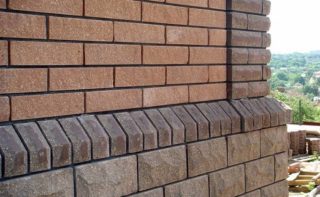
Natural material lasts longer and is an expensive option. Artificial material in the form of tiles imitates natural stone, is cheaper, but can crack from frost or with prolonged exposure to moisture.
Types of natural stone:
- granite comes in a variety of shapes, such as large or small slabs, torn or polished surfaces;
- sandstone is produced in light sand colors, produced in the form of cut slabs or stones with uneven edges;
- shell rock is stronger than sandstone, has a porous surface, and is treated with special primers during installation;
- wild stone "limestone" is used for the base in the form of quartzite and slate, has a dense structure and high resistance to climatic aggression.
The lower part of the house is covered with a metal mesh, which is attached with dowels to the base and is the basis for installing artificial or natural material. The seams are filled with mortar and processed with jointing.
With the help of corrugated board
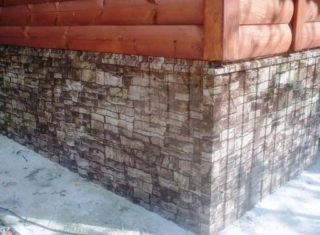
The material is an affordable and inexpensive base / plinth cover. For production, certain grades of metal are used, which guarantee durability and reliability during operation. Profile waves are square, rectangular, and can have sharp or semicircular edges. The surface is treated with paints and varnishes.
The corrugated board is available in various colors, imitating the surface of stone, brick, wood of different varieties. The pedestal of the house is finished in tone with the main walls or acts in a contrasting combination.If the walls are made with a timber profile, the plinth can be sheathed with a material imitating brick or wild stone. From a distance it will look like a wooden house with a high, solid base.
You can make a plinth from a profiled sheet yourself, but you need to carefully calculate the dimensions when cutting. For ease, start and end strips are used, framing strips are used for basement doorways and corner decoration.
With siding
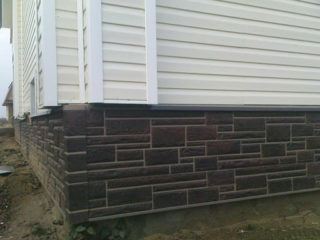
The material also conveys the surfaces of natural and artificial species, for example, wood, shingles, braids. The siding is placed on a frame, where insulation in mats or strips is simultaneously laid. There are varieties of volumetric panels, where an insulating foam pad is inserted between two layers of plastic.
The frame racks are placed in a direction perpendicular to the material strips. Wooden slats or metal profiles are used. The tree is treated with antiseptic and anti-decay impregnations and only dried timber is taken. For fastening to the base, special brackets are used, the length of which is adjustable for the horizontal and vertical level. The insulation is installed in the resulting niches and fixed with dowels with round caps (mushrooms).
The finish is chemically resistant and does not react to acid precipitation, alkaline effects, does not deteriorate at a temperature of -50 - + 60 ° C, it is easy to clean with water and detergents.









It turned out very cool, I have the same work. Thanks for your clarity!